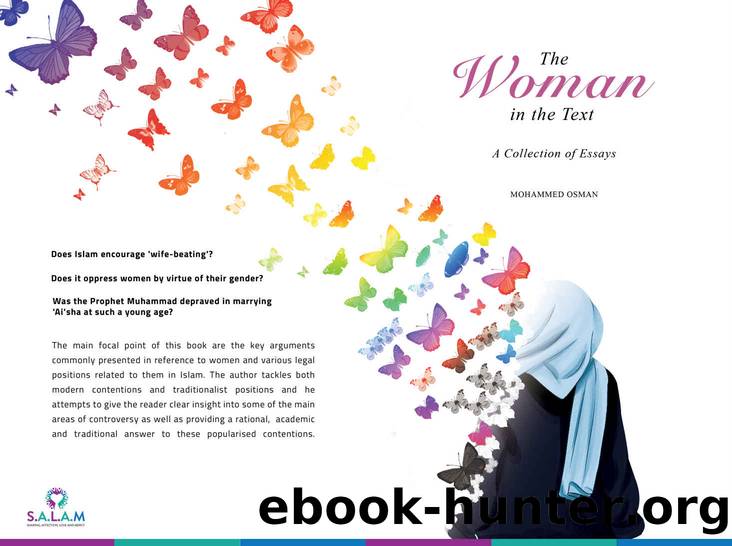The Woman in the Text: A Collection of Essays by Osman Mohammed

Author:Osman, Mohammed [Osman, Mohammed]
Language: eng
Format: epub
Publisher: SALAM Publications
Published: 2019-05-12T16:00:00+00:00
Hadith Narration ( RiwÄyah )
Drawing a comparison between testimony and hadith narration, there appears to be no dissimilarity between males and females, despite the importance and brevity of these actions. Al-HÄfith al-âIrÄqi (d. 806 H) formalises the conditions of an authentic hadith in his Alfiyyah (a versification of Ibn al-Salahâs magnum opus, An Introduction to the Science of Hadith ):
And the first (category) is a connected chain of transmission
By the one who is trustworthy (âadl) and reliable (dhÄbit) . [xc]
The two prerequisite conditions for the acceptance of a narrator was their âadÄlah (trustworthiness) and âdhabt (reliability). This gender neutrality been echoed throughout the centuries in hadith sciences, and has been taken as near consensus. There were many prolific hadith narrators who were women, chief of which was the Prophet Muhammadâs (PBUH) wife âAisha, who was amongst the most prolific of the companions who have narrated this important source of legislation. Recent research by In his voluminous work al-MuhaddithÄt: The Women Scholars in Islam , Akram Nadwi outlines the biographies of over eight thousand women scholars of hadith. [xci] Amazingly, the 8 th century historian Imam al-Thahabi (d. 748 H) said, âI am unaware of a single woman who narrates hadith that has been accused of lying, nor one who has been rejected due reliability.â [xcii] A similar statement has been reported by the 8 th century hadith scholar Ibn Hajr (d. 852 H). [xciii]
The question may be asked: what led to the demarcation between hadith narration and shahÄdah with respect to women? One immediately notes that there does not exist a consensus amongst Islamic scholars as to the cause of this binary division. Some scholars seemingly understood this point and inferred that the sociocultural milieu may have played an active role in determining whether plurality in womenâs testimony was indeed a requirement. In his seminal work Iâlam al-Muwaqqiâin , Ibn al-Qayyim (d. 751 H) asserts that if a woman could prove herself to be trustworthy and dependable in other areas, then her testimony should be accepted, irrespective of the area:
If a woman is credible and trustworthy in her religiosity, then the intended objective has been reached with her testimony, and as such, her lone testimony is accepted in certain places. [xciv]
In his magnum opus on Islamic judicial law, Ibn QudÄmah (d. 620 H) states various scenarios in which a womanâs singular testimony is accepted over a manâs due to these scenarios being generally more attended and witnessed by females:
(A womanâs lone testimony) is accepted in that which men are not usually privy to, such as issues connected to breastfeeding, childbirth, menses, âiddah , and affairs similar to these. We do not know of any difference of opinion amongst the scholars regarding this. [xcv]
Thus, the question of whether the ratio legis of verse 2:228 was based on a prevalent sociocultural or economical milieu is still present and argued strongly by numerous scholars such as Ibn Taymiyyah and Ibn al-Qayyim.
QiwÄmah - Financial Responsibility
With regard to the acquisitioned ( kasbi ) reason behind
Download
This site does not store any files on its server. We only index and link to content provided by other sites. Please contact the content providers to delete copyright contents if any and email us, we'll remove relevant links or contents immediately.
Machine Learning at Scale with H2O by Gregory Keys | David Whiting(3666)
Never by Ken Follett(3550)
Fairy Tale by Stephen King(2976)
The Man Who Died Twice by Richard Osman(2824)
Reminders of Him: A Novel by Colleen Hoover(2781)
Will by Will Smith(2595)
It Starts With Us (It Ends with Us #2) by Colleen Hoover(2059)
The Dawn of Everything: A New History of Humanity by David Graeber & David Wengrow(2025)
Friends, Lovers, and the Big Terrible Thing by Matthew Perry(2018)
Can't Hurt Me: Master Your Mind and Defy the Odds - Clean Edition by David Goggins(2012)
The Stranger in the Lifeboat by Mitch Albom(1947)
The Becoming by Nora Roberts(1934)
Love on the Brain by Ali Hazelwood(1828)
New Morning Mercies: A Daily Gospel Devotional by Paul David Tripp(1821)
HBR's 10 Must Reads 2022 by Harvard Business Review(1703)
The Strength In Our Scars by Bianca Sparacino(1702)
A Short History of War by Jeremy Black(1679)
Go Tell the Bees That I Am Gone by Diana Gabaldon(1602)
515945210 by Unknown(1525)
